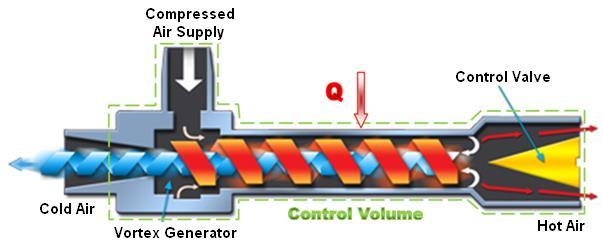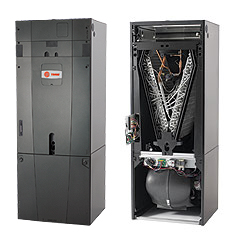Get Tech Tips
Subscribe to free tech tips.
RH, DB, and WB
I recently received a message asking for a discussion of relative humidity (RH), wet-bulb (WB), and dry-bulb (DB). Time and time again, I hear techs say that condensation occurs when “hot meets cold,” which may be true in some cases. However, that is only a shorthand way to describe it and doesn't really address what is going on when we see condensation and undesirable growth.
RH = Relative humidity; the percentage of humidity relative to the amount of moisture can hold at that temperature.
I like to think of it as sugar in a cup of coffee. The hotter the coffee, the more sugar the coffee can hold.
When we say the air is “humid,” we can mean it contains a lot of absolute moisture in grains or pounds, or we can mean it is high “relative” humidity, which is the more common meaning. Air that's 95°F at 50% RH contains far more moisture per lb of air than 65° air does at 50% RH.
It's a common misconception that hot air is more humid. While it's true that hotter air can hold more moisture in the same way that hotter coffee can hold more sugar, it does not mean hotter means more humid. In fact, if you heat a mass of air and the amount of moisture doesn't change, the RH will go down as the air gets warmer. This is why the RH coming out of the top of a furnace is lower than the RH going in. No change has occurred in the actual amount of moisture present; the air is just hotter, therefore lower in humidity relative to how much it can hold.
DB = Dry-bulb; the temperature of air without taking account for evaporation/relative humidity
WB = Wet-bulb; the temperature of the air with the evaporative effect of a “wet bulb” taken into account. Quite literally, wet-bulb temperature is the temperature a thermometer bulb will be when covered in a wet fabric and whirled in the air or placed in an air stream.
If the RH is below 100%, the WB will always be lower than the DB. The differential between the DB and WB illustrates the RH. The higher the differential, the lower the RH. The lower the differential, the higher the RH. When DB and WB read the same, the RH is 100%, and the air is “saturated.” No more evaporation can occur.
When air hits 100% RH, the dry-bulb and wet-bulb temperatures are the same, and this point is known as “dewpoint.”
—Bryan











Comments
Wow, nice metaphor bryan. Using hot coffee as an example of how hotter air can hold more moisture
Wow, nice metaphor bryan. Using hot coffee as an example of how hotter air can hold more moisture
pharmacie en ligne france livraison belgique: Pharmacie en ligne France – pharmacie en ligne avec ordonnance pharmafst.com
pharmacie en ligne france livraison belgique: Pharmacie en ligne France – pharmacie en ligne avec ordonnance pharmafst.com
kamagra 100mg prix: kamagra oral jelly – kamagra livraison 24h
kamagra 100mg prix: kamagra oral jelly – kamagra livraison 24h
Cialis sans ordonnance 24h: Pharmacie en ligne Cialis sans ordonnance – Achat Cialis en ligne fiable tadalmed.shop
Cialis sans ordonnance 24h: Pharmacie en ligne Cialis sans ordonnance – Achat Cialis en ligne fiable tadalmed.shop
kamagra oral jelly: Achetez vos kamagra medicaments – Kamagra Oral Jelly pas cher
kamagra oral jelly: Achetez vos kamagra medicaments – Kamagra Oral Jelly pas cher
Tadalafil 20 mg prix en pharmacie: Acheter Cialis 20 mg pas cher – cialis sans ordonnance tadalmed.shop
Tadalafil 20 mg prix en pharmacie: Acheter Cialis 20 mg pas cher – cialis sans ordonnance tadalmed.shop
vente de mГ©dicament en ligne Achat mГ©dicament en ligne fiable or Pharmacie sans ordonnance
http://www.google.com.fj/url?q=https://pharmafst.com vente de mГ©dicament en ligne
[url=https://cse.google.st/url?q=https://pharmafst.com]pharmacie en ligne france livraison belgique[/url] Achat mГ©dicament en ligne fiable and [url=http://lzdsxxb.com/home.php?mod=space&uid=4353252]pharmacie en ligne france livraison internationale[/url] pharmacie en ligne livraison europe
vente de mГ©dicament en ligne Achat mГ©dicament en ligne fiable or Pharmacie sans ordonnance
http://www.google.com.fj/url?q=https://pharmafst.com vente de mГ©dicament en ligne
[url=https://cse.google.st/url?q=https://pharmafst.com]pharmacie en ligne france livraison belgique[/url] Achat mГ©dicament en ligne fiable and [url=http://lzdsxxb.com/home.php?mod=space&uid=4353252]pharmacie en ligne france livraison internationale[/url] pharmacie en ligne livraison europe
olympe: olympe casino avis – olympe casino
olympe: olympe casino avis – olympe casino
Hello, after reading this remarkable piece of writing i am too cheerful to share my familiarity here with friends.
Hello, after reading this remarkable piece of writing i am too cheerful to share my familiarity here with friends.
Thhank you
Thhank you
kamagra livraison 24h: kamagra livraison 24h – kamagra 100mg prix
kamagra livraison 24h: kamagra livraison 24h – kamagra 100mg prix
To leave a comment, you need to log in.
Log In